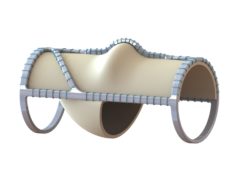
While developing specific treatment for primary lymphoedema presents an “enormous” scientific challenge, secondary lymphoedema may prove an easier target, Oliver Lyons writes for Venous News. In this article, Lyons outlines what is currently known, and what to expect in the near future.
There are many drugs available for treating disorders of the blood circulation, but there are none for use in lymphoedema. The lymphatic system is complex and its physiology, for example the mechanisms controlling active lymphatic pumping in vivo, remains less well understood. The scientific challenge in treating primary lymphoedema is enormous. Over 20 different genes may be mutated causing a primary lymphoedema. The resulting anatomical and functional deficits in each disease can be surprisingly different. For example, Milroy’s disease (caused by mutations in FLT4, encoding VEGFR3) leads to a capillary uptake problem on scintigraphy, whilst mutations in the transcription factor FOXC2 most commonly lead to hyperplastic channels and dermal reflux. Correcting the underlying problem in each of many different genetic diseases may require many different therapies (albeit some may be grouped together).
There have been many historical trials of therapeutic agents for lymphoedema, including over 15 trials assessing the Benzo-pyrones, but without any convincing evidence of clinical benefit, and with concerns around hepatotoxicity. More recently, researchers at Stanford University (Stanford, USA) have taken a different approach. The chronic interstitial fluid accumulation in lymphoedema leads both to changes in the structure of the skin and also to impaired clearance of inflammatory cells and mediators, with dysregulated regional immune responses. Adipose tissue deposition and fibrosis lead to progressive anatomic distortion and eventually loss of function in the affected areas. Rather than trying to target the specific defect causing the lymphoedema, scientists have targeted these downstream inflammatory processes by reducing the production of Leukotriene B4, a short-lived inflammatory mediator that at higher concentrations inhibits lymphatic endothelia. This approach, targeting a “common pathway”, might prove to be helpful in all forms of lymphoedema, and several drugs are known to inhibit the production of Leukotriene B4, including Ketoprofen and the Leukotriene A4 hydrolase inhibitor Ubenimex.
In a small randomised controlled trial in a group of patients with primary or secondary lymphoedema, treatment with Ketoprofen did not reduce lower limb swelling, but did produce improvements in skin histology. Unfortunately after study recruitment was completed, the US Food and Drug Administration (FDA) issued a black box warning for Ketoprofen, and there are concerns about the long-term use of this drug. Whilst this is disappointing, the ability to produce histological improvement in patients with lymphoedema is nevertheless a positive step in the right direction. A further trial is examining Ubenimex, which is more targeted in its action than Ketoprofen; unlike Ketoprofen it does not inhibit Cyclooxygenase 1 or 2. Unfortunately the study sponsor, Eiger BioPharmaceuticals, have released a statement (in October 2018) indicating that the primary endpoint of skin thickness and secondary endpoints of limb volume and bioimpedance have not been met. Full publication of the results of this study is still awaited and it remains unknown whether certain groups of patients might respond better than others to particular treatments.
In comparison to primary lymphoedema, secondary lymphoedema might prove to be an easier target for pharmacotherapy. Whilst there are some genetic polymorphisms (e.g. in GJC2) that may increase a person’s risk of secondary lymphoedema (e.g. after treatment of breast cancer), the lymphatics should more readily respond to stimulation.
The central molecule that directs proliferation and migration of lymphatic endothelial cells is vascular endothelial growth factor C (VEGFC), acting through VEGFR3. VEGFC has been used successfully in murine and swine models of secondary lymphoedema. Herantis pharma (based in Finland) have now taken this forwards in the AdeLE trial, which examines the effect of combining lymph node transfer with adenoviral delivery of VEGFC in women with breast cancer. The Phase 1 results have not raised safety concerns, and efficacy results are anticipated in 2020.
Globally, the most common cause of lymphoedema is infection with filarial worms. In a randomised controlled trial in a single setting (Ghana) assessing the use of Doxycycline for the treatment of filiariasis, it was found that patients’ lymphoedema stage improved regardless of the presence of active infection. This led the authors to suggest that a wider group of patients with lymphoedema might benefit from annual courses of doxycycline. It is, however, too early to recommend routine use of doxycycline in patients with non-filarial lymphoedema, and further research is ongoing.
In summary, great progress is being made in this field, and has been marked by the first pharma-sponsored trial of a drug therapy for lymphoedema, and by the first clinical-stage gene therapy that aims to repair damaged lymphatics. The development of histological outcome measures (rather than simply limb swelling) is another important step forwards. Further collaborative trials will be needed in order to bring pharmacotherapy for lymphoedema into routine clinical use.
Oliver Lyons FRCS PhD is an honorary Clinical Lecturer in Vascular Surgery at King’s College London, UK.










if one has impaired kidney function and ketoprofen impacts that function, are there treatments to correct this side effect?